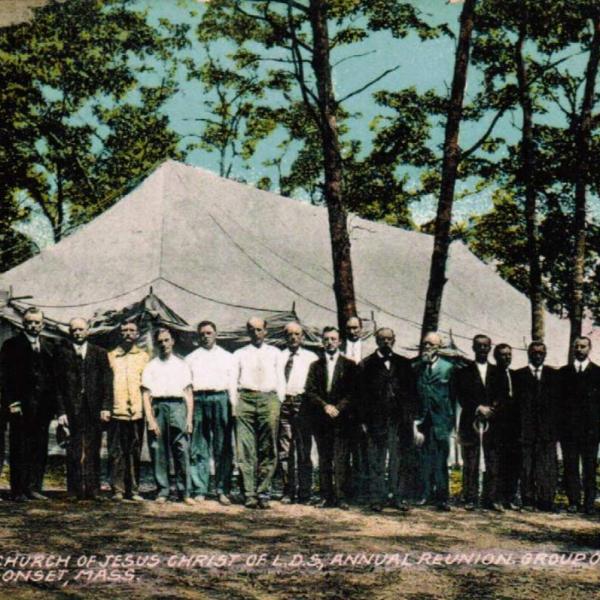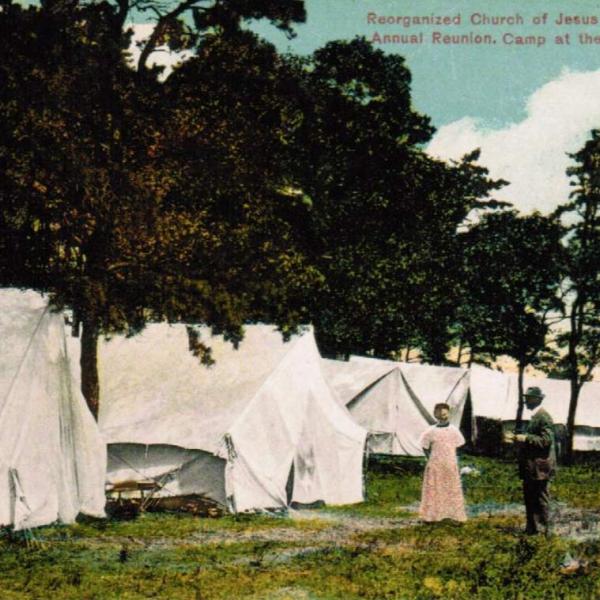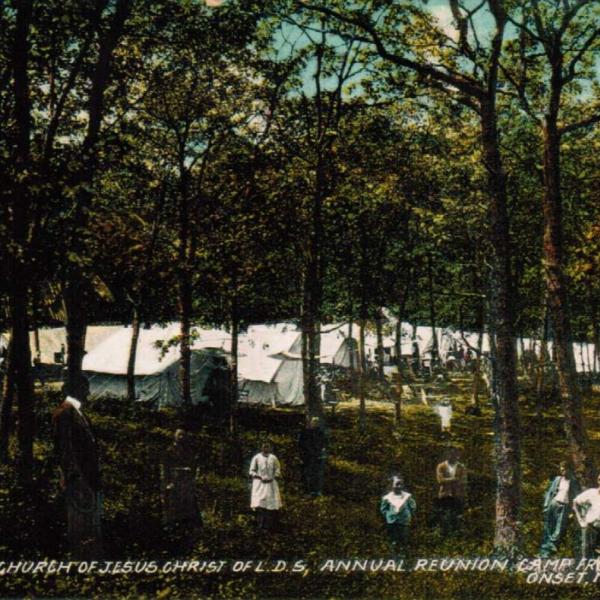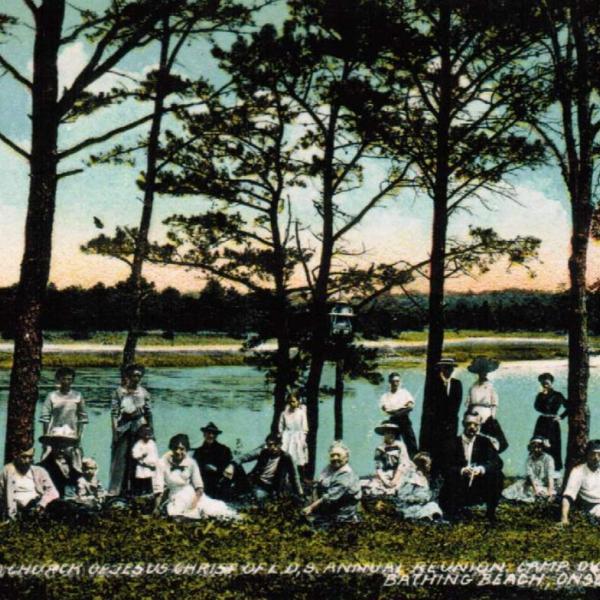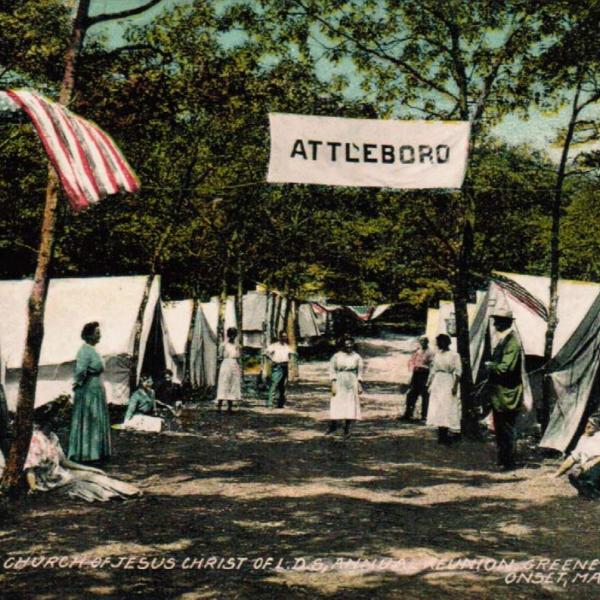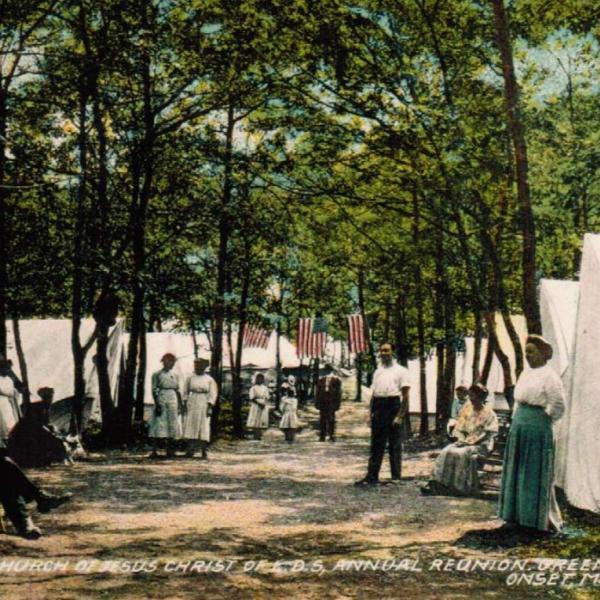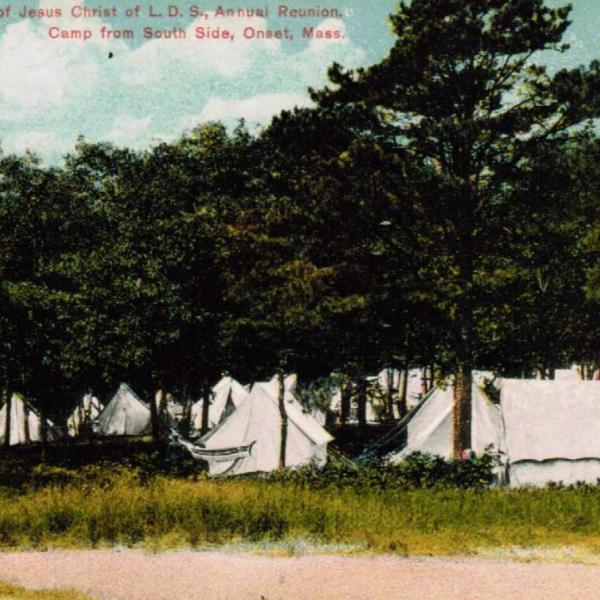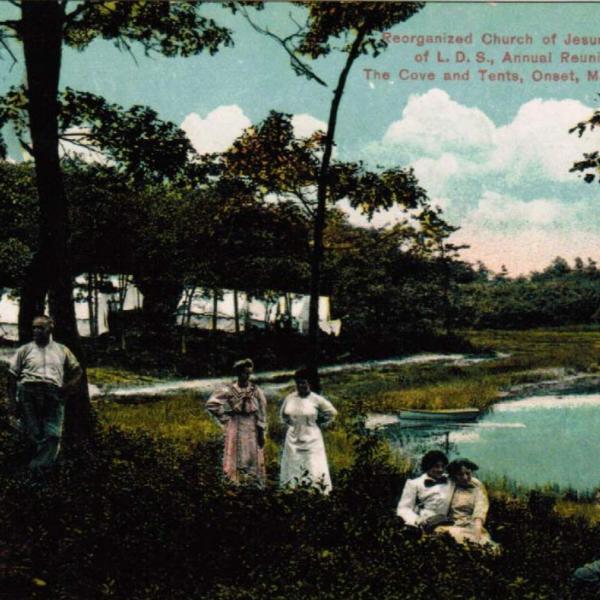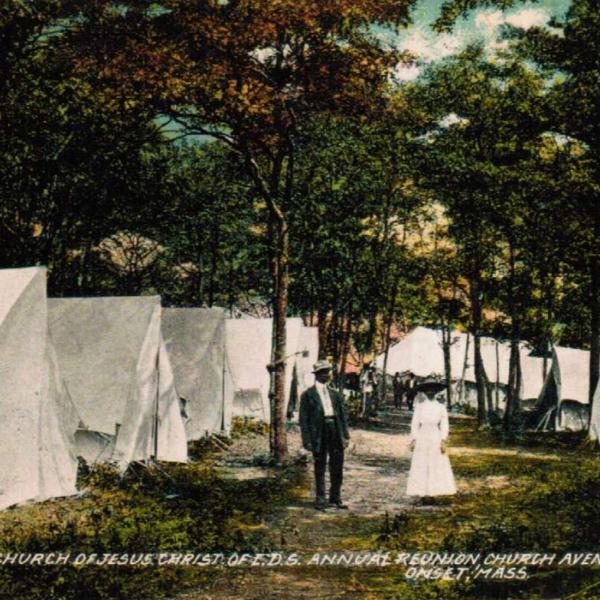The Wôpanâak, or Wampanoag tribe were the first people on the lands that are now the Onset Campgrounds.
The Onset Campgrounds was purchased in 1911, by the Reorganized Church of Jesus Christ of Latter-Day Saints (RLDS), now the Community of Christ, as a reunion grounds for the Southern New England District of the Church. In the RLDS tradition, reunions are gatherings of members of the Church from all the congregations from within a geographically-defined area (like the Southern New England District), for a short time (1-2 weeks), typically in the summer. Leaders of the Church from other parts of the country often attend these reunions, giving sermons, facilitating discussions, teaching classes, and generally inspiring reunion participants.
Throughout the week, or weeks, members of all ages participate in worship services, classes, and recreational activities. Church families bond and grow in their love of one another and Jesus Christ, and leave these reunions rejuvenated and reinvigorated to go home and lead Christ-like lives. Prior to the purchase of the Onset property, from 1896 - 1910, the District held reunions at a variety of rented locations, including in Maine (Jonesport), Rhode Island (Touisett and Touisett Point), down the Cape (Dennisport), and nearby (Silver Lake).
The Property
The land that now comprises the Campgrounds was purchased incrementally, starting with about 48 acres (34 upland + 14 marsh) in 1911, almost 17 years after the District created a five-person committee to find and purchase a place for the perpetuation of annual reunions (by action of the District Conference, May 1894). This acreage, at the gateway to Cape Cod, surrounding Muddy Cove, and which formerly served as a Native American Summer Camp, was purchased with monies donated by members of the District, in the same way many other RLDS Districts across the country, and even the world, have purchased campgrounds throughout the history of the Church.
In 1912, District leaders hired a surveyor to plot out a map for the development of the campgrounds that envisioned a tabernacle, athletic grounds, and nearly 250 campsites on approximately 29 acres.
In 1965, the Church purchased about 17 acres of abutting land on the northwest side of the original grounds, which have never been developed.
Reunions
At first, starting summer 1911, members of the RLDS Church in the Southern New England District gathered on the Campgrounds each summer for a two-week Reunion, living in tents, dining communally, and using shared washhouses and outhouses. Photos of reunions from these early days, below, show large numbers of tents and campers. As can be seen in the photos, different congregations in the District stayed in tents clustered together. The photo shows the Attleboro, MA congregation’s cluster. These reunions continue to take place annually on the Onset Campgrounds, although now they are just one week-long, and at other Community of Christ Campgrounds around the world, today.
Evolution to a Year-Round Community
Wanting to stay drier and warmer, and be more comfortable, families attending the Onset reunions soon began to build platforms on which they would erect their tents for reunion each summer. As a result, families began to set up in the same location year after year, on the platforms they had built. As early as 1915, according to Town records, families began to build onto these platforms, erecting solid walls with doors and shuttered window openings, and putting on roofs. To provide Reunion housing for church members who didn’t have a platform or a “cottage,” congregations took responsibility for building “hutments” on the Campgrounds. Six of these buildings are still standing and available for rent, today, including the Providence Hutment and the Attleboro Hutment, named after the congregations that built them. After WWII, the campgrounds obtained six small cabins from the nearby air force base. No longer needed to house military personnel before being sent overseas, these compact, primitive dwelling provided additional reunion housing for people without tents or cottages. One of these cabins remains to this day. It stands near the ballfield, serving as a storage shed for the campground’s athletic equipment.
Before long, families began to arrive well before Reunion started and stayed in “their cottages” after Reunion ended. From the 19-teens or early 1920s into the 1960s and 70s, it was common for mothers and children to stay on the Campgrounds, in their cottages, all summer, with the fathers joining them for Reunion and on weekends. Over time, families began upgrading and modernizing their cottages, adding foundations and even basements, windows, and porches. Over time, some families demolished their primitive abodes and built proper houses, with kitchens and bathrooms, in their place, while others donated their simple cottages to the Church, which moved the buildings to a different location on the Campgrounds. The current Sheehy and Chesworth Buildings, named in honor of the families who donated them, are examples of this, that we continue to use today as classroom spaces. Others who never had these “evolved tents,” purpose-built summer cottages, and eventually year-round homes, from the ground up. While there are now about 60 year-round homes on the Campgrounds, there are still, to this day, a few summer cottages that retain remnants of those original simple cottages, albeit, they all now have kitchens and bathrooms. Through all this, while individuals or families own the dwellings on the Campgrounds, the land beneath them, these beloved campgrounds, belongs to the Church. Currently, there are 81 residential dwellings (cottages or houses) on the campgrounds. Many of these dwellings are passed down from generation to generation, although owners may choose to sell them to another church member. Several of the houses on the campgrounds today have been in the same family since they were built in the 1920s. The church-ties, the family ties, and the generational-ties serve to create a community of “saints” (as members of the RLDS church are traditionally called) that have a strong bond with one another as well as to the Church. The connection between cottage owners on the Campgrounds now extends far beyond a two-week reunion in the summer. Cottage owners gather, worship, pray, commune and play together in a variety of ways throughout the year, epitomizing the Community of Christ’s Mission to proclaim Jesus Christ and promote communities of joy, hope, love, and peace.
Governance
The campground was originally under the stewardship of the First Presidency of the Church, with District President F.M. McDowell and Bishop JA Becker to get things started. For some time thereafter, the Grounds were essentially under the full control of the local Bishop, Myron C. Fisher. Later a Board of (five) Stewards was created, with members appointed by the Presiding Bishop. In 1939, the Board was increased from five to seven Stewards. The original Trust Agreement of the Stewards was even filed in the Plymouth County Court House.
The governing body, and the scope of its authority changed several times over the years. Governing bodies have included, “the Trustees of the Southern New England Development Association”, “the Onset Grounds Committee,” and the Onset Board of Trustees. There has typically been a division between some sort of Board of Stewards or Trustees, responsible for the business affairs (maintenance and operation) of the property, and the District President, Mission Center President, or Bishop, responsible for planning and conducting the spiritual affairs of the Campground.
In 2000, the Church dissolved the Southern New England District, and created the New England Mission Center (NEMC). On September 3, 2000, the members of the former Southern New England District and campgrounds leaseholders held a meeting at which they approved an “Onset Conference” comprised of 1) baptized members of the Community of Christ AND 2) registered members of a branch within the boundaries of the former SNE District OR land Leaseholders on the Onset Campground. They also elected and appointed an 11-member Board of Trustees at that time, authorized to create bylaws and related rules, regulations, and procedures for the management of the Campgrounds and its programs, exclusive of the annual Reunion and other activities under the jurisdiction of the NEMC. Then, on September 23, 2000, at the NEMC Conference, the NEMC created and empowered the Onset Conference to conduct the operation, maintenance and programs of the Onset Campground as it sees fit.
Facilities
The centerpiece of the Campgrounds is, and always has been, the Tabernacle. A gathering place for worship, it has a capacity to seat 200. It was built in 1912, and like many of the cottages on the Campgrounds, has survived several significant hurricanes, including the Category 5 hurricane of 1938. The Tabernacle is a Historic Building for the Town of Onset and for the Community of Christ. The original wash houses, the commissary/dining hall, which for a time served as a thrift shop, and a one-time dormitory are long gone. A winterized cottage was donated to serve as a smaller winter chapel for the Onset Congregation, as more people began to live on the campgrounds year-round, and is still used as the winter chapel today. A Youth Chapel, with a capacity of 125, a Recreation Center/Dining Hall with a kitchen, and attached restrooms and showers was built circa 1960s. A breezeway was added later to connect the Youth Chapel to the Rec Center. The Roberts Family donated their house on the Grounds to the Church. It is called The Roberts House to this day and is used to house visiting ministry. The old Austria Motel from East Wareham and The Sandwich Motel were purchased and moved on to the Campgrounds circa 1980. They were gradually converted into five apartments for Church members, and eight short-term rentals, called the Muddy Cove Retreat Center, to provide church members who don’t have cottages on the Grounds a place to stay and be in communion with their fellow “saints” for short lengths of time, or for non-members attending Church functions on the Grounds, such as weddings and reunions, to stay. As noted earlier, there are also six little hutments available for short stays. The New England Mission Center is currently renovating a building that for several decades served as a Creative Arts Facility on the Campgrounds. Once complete, it will serve as a “Spiritual Life Center” where a variety of seminars, services and activities will be hosted.
In addition to the indoor facilities, today the campgrounds boasts 14 designated campsites, a tennis court, a tennis court used as a pickle ball court, a sand volleyball court, a playground, a ball field, a beach (“The Point”), and a meditation garden (“Serenity Park”). The church/Board of Trustees also maintains a variety of recreational equipment on the grounds, including a floating dock/raft, and several kayaks
